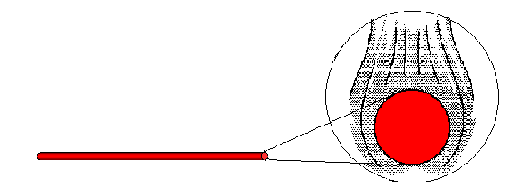

Project by Jesse
Gracia & Dennis Krueger
Convective heat transfer occurs due to movement of a fluid near a solid when the solid and the fluid are at different temperatures. Free convection, a limiting case of convection, occurs due to the natural movement of the fluid in the vicinity of the solid. This natural movement results from changes in the density of the fluid at different temperatures. A cool fluid in contact with a hot solid will be heated adjacent to the solid. The heating will cause it to expand and rise, carrying heat with it, with the resulting flow patterns being determined by the buoyant effect of the heated fluid. This effect is different than that in forced convection, where the flow patterns are determined by some external force.
In free convection problems, it is generally assumed that the temperature at the surface of the object (T0) remains constant and the temperature far from the object (Tinf) also remains constant. The properties of the fluid are determined at the mean film temperature (Tf) which occurs at the solid-fluid interface given by the below function.
A heat transfer coefficient (hm), for free convection from a cylinder is computed. Generally, the free convection heat transfer coefficient is calculated from an empirical equation which gives the dimensionless Nusselt number as a function of two other dimensionless numbers, the Prandtl number and the Grashof number. The Nusselt number is given by
where D is the diameter and k is the thermal conductivity at Tf.
The Prandtl number is given by
where Cp is the specific heat capacity of the fluid and m is the viscosity of the fluid.
The Grashof number is given by
where r is the density of the fluid, b = 1/Tinf and g is the gravitational constant.
The rate of heat generation equals the rate of heat lost and is given by the below equation
where q is heat lost per unit length, A is the area, and dT = (T0 - Tinf).
In the first problem the surface temperature and ambient air temperature are specified and the rate of heat generation needed to maintain this surface temperature of a small metal wire (cylinder) is determined. For this example, the empirical equations used to calculate the Nusselt number were not used. Experimental data was digitized, replotted, and a fourth order polynomial was fitted to the data (see Figure 1). This polynomial was then used to obtain the Nusselt number from the product of the Grashof and Prandtl numbers, thereby obtaining a value based on experimental observations.